Egon Schiele
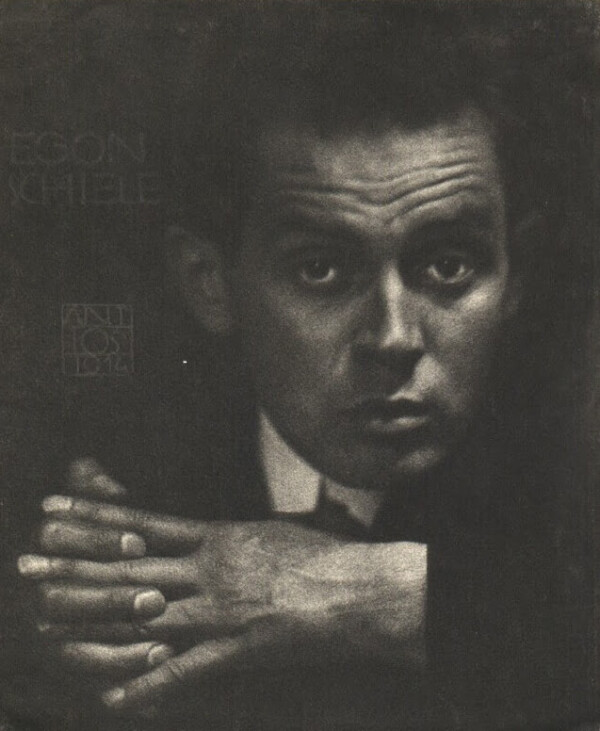
Egon Schiele photographed by Anton Josef Trčka, 1914
© The ALBERTINA Museum, Vienna
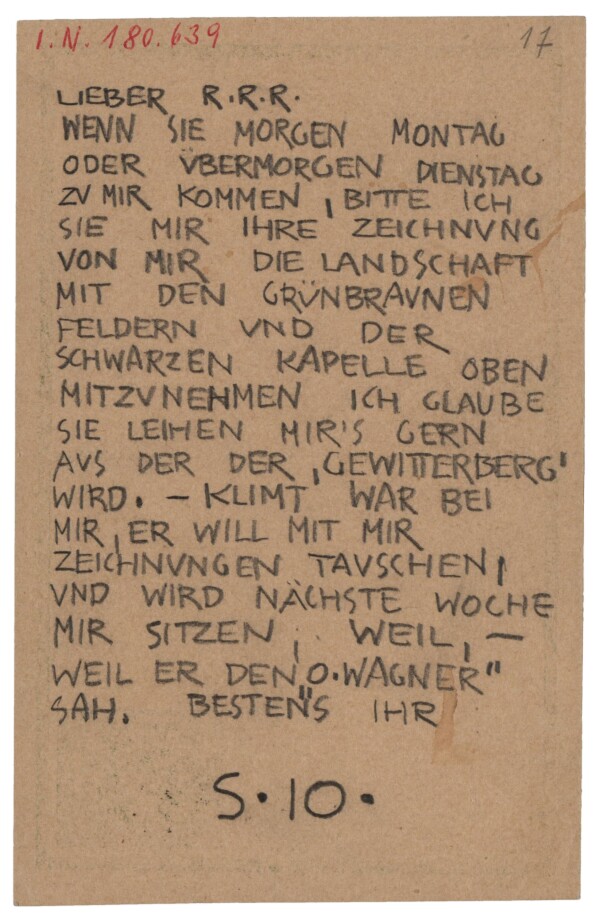
Egon Schiele: Correspondence Card from Egon Schiele in Vienna to Arthur Roessler in Vienna, 11/27/1910, Wienbibliothek im Rathaus
© Vienna City Library, Manuscript collection
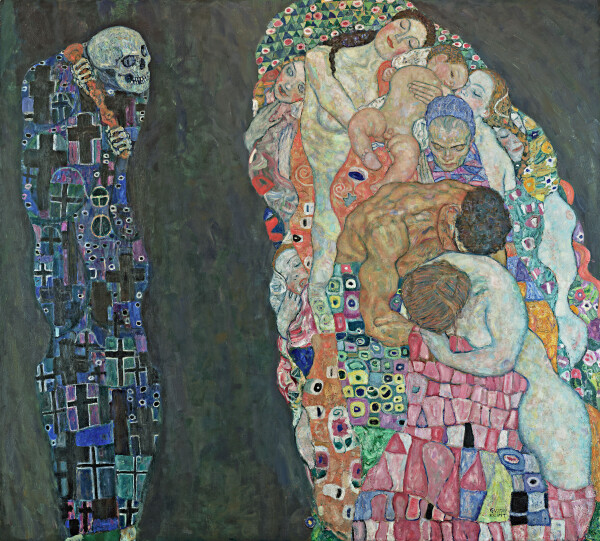
Gustav Klimt: Death and Life (Death and Love), 1910/11 (überarbeitet: 1912/13, 1916/17), Leopold Museum
© Leopold Museum, Vienna
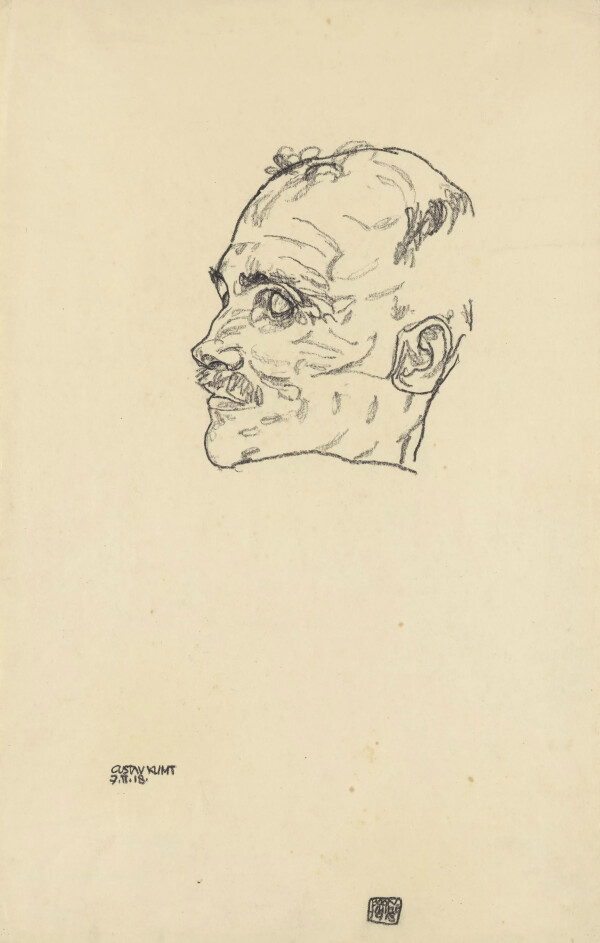
Egon Schiele: Gustav Klimt on his deathbed (detail), 07.02.1918
© Wien Museum
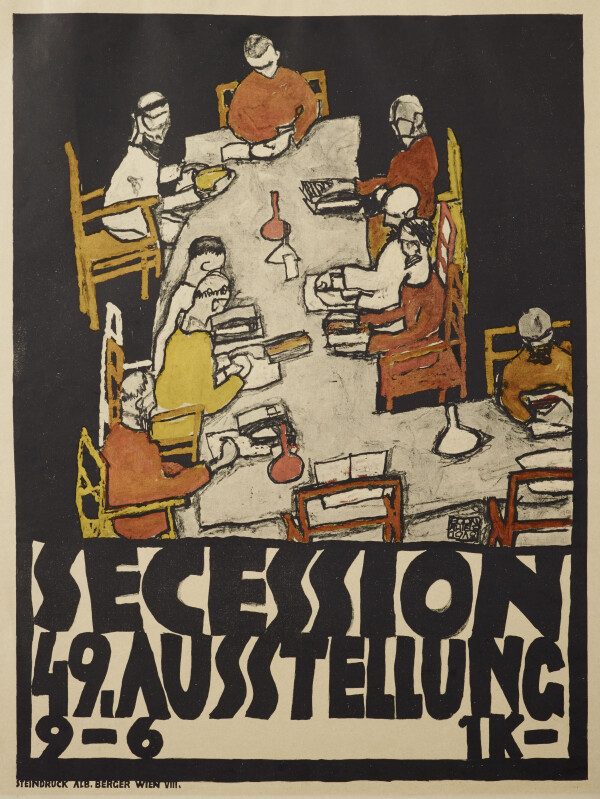
Egon Schiele: Poster for the XLIX. Exhibition of the Vienna Association, 1918
© Klimt Foundation, Vienna
Egon Schiele and Gustav Klimt represent two different generations of outstanding artists in the era of Viennese Modernism. Schiele, who turned towards Expressionism, found his mentor in Klimt, the great master of Jugendstil.
Egon Schiele’s Early Interest in Art
Egon Schiele was born in Tulln on the Danube on 12 June 1890. After graduating from school, where he had received mixed grades, he began studying at the Vienna Academy of Fine Arts in 1906; his teachers included Christian Griepenkerl. He presented some of his works for the first time at Klosterneuburg Abbey in 1908. It was in this context that the young artist met Heinrich Benesch, who would become instrumental for his future career. That same year, Schiele also visited the “Kunstschau Wien,” which was organized by the Klimt Group and had a lasting influence on Schiele.
Schiele turned out to be an “incorrigible, unacademic and recalcitrant student.” Griepenkerl’s antiquated methods of teaching caused the artist to write a letter of protest and to leave the Academy in 1909. This was followed by the founding of the Neukunstgruppe. During a preliminary inspection of this new group’s first exhibition at the Pisko Gallery in December of the same year, Schiele met Arthur Roessler, who would become his indispensable confidant and patron. Roessler also introduced the young artist to Carl Reininghaus, Oskar Reichel and Eduard Kosmack.
No Generational Conflict. Schiele and Klimt
Schiele presumably met Klimt for the first time at the latter’s studio at Josefstädter Straße 21 (Vienna-Josefstadt, 8th District) in 1907. Their connection turned out to be very important, especially for the younger artist: Schiele chose the master painter as his mentor. On the invitation of Klimt, Egon finally presented some of his works at the “Internationale Kunstschau” in 1909, including his Portrait of the Painter Anton Peschka (1909, privately owned). This work clearly betrays Schiele’s exploration of Klimt’s stylistic idiom and the art of Jugendstil.
In the following years, the two painters met repeatedly – also, as Arthur Roessler recalled, at Schiele’s studio at Grünbergstraße 31 (Vienna-Meidling, 12th District). Klimt is said to have studied the young artist’s work and to have remarked respectfully:
“I envy you for the expression on the faces you painted there, on these pictures!”
The artists went on to exchange drawings and Klimt is also said to have purchased a drawing by Schiele.
They participated in exhibitions together and sometimes met at social activities, including nine-pin bowling at Restaurant Hartmann at Kärntnerring 10 (Vienna’s Inner City, 1st District) and probably also gatherings at Klimt’s favorite restaurant Meierei Tivoli (Vienna-Meidling, 12th District).
Schiele’s Stylistic Development
From 1910, Schiele developed his own, unmistakable Expressionist style. He concluded in November of the same year:
“I passed through Klimt until March. Today I believe I am very different.”
In 1911, Schiele and Wally Neuzil were staying in Krumau (now Český Krumlov), his mother’s birthplace. He created exceptional views of the city, portraits and self-portraits. Furthermore, he had his first exhibition at the H. O. Miethke Gallery, which also represented Gustav Klimt.
In 1912, Schiele lived in Neulengbach, where he was held in custody, facing charges for the alleged abduction and violation of a minor. These accusations proved to be unfounded. Dismayed by nude drawings that were found in Schiele’s studio, the court sentenced him to three more days of imprisonment. In October, Schiele moved into his attic studio at Hietzinger Hauptstraße 101 (Vienna-Hietzing, 13th District), close to Klimt’s last studio at Feldmühlgasse 11 (previously Feldmühlgasse 9). Around this time, Schiele also met his patron Franz Hauer and was introduced by Klimt to the Lederer family. Erich Lederer, in particular, became another patron. Also in 1912, Schiele created his work The Hermits (1912, Leopold Museum, Vienna), possibly a double portrait of himself and Klimt. This painting was first exhibited that same year at the “Frühjahrsausstellung” [“Spring Exhibition”] of the Hagenbund.
In early 1913, Schiele became a member of the Austrian Artists’ League, presided over by Klimt. In autumn, Schiele participated in an exhibition in Budapest together with this artists’ association.
World War I
The turmoil of war notwithstanding, Schiele participated in numerous international exhibitions. In late 1914, the “Kollektiv-Ausstellung Egon Schiele” [“Egon Schiele Collective”] was held at the Arnot Gallery in Vienna, where Schiele for instance presented his Portrait of Friederike Maria Beer (1914, privately owned). Following an introduction by the painter Hans Böhler, Klimt also began to create a portrait of Miss Beer one year later.
In 1914, the Czech-Austrian photographer Anton Josef “Antios” Trčka created a series of expressive photographic portraits of both Schiele and Klimt. Schiele met the Harms sisters; he married Edith the following year.
In 1916, both Klimt and Schiele were represented at the “Wiener Kunstschau in der Berliner Secession” [“Vienna Kunstschau at the Berlin Secession”]. Klimt’s painting Death and Life (1910/11, reworked: 1912/13, 1916/17, Leopold Museum, Vienna) and Schiele’s painting Levitation (The Blind II) (1915, Leopold Museum, Vienna) were presented opposite each other. Schiele’s Expressionist style is clearly discernible, but Klimt’s work also visualized his own version of Expressionism, which was characterized by ornamentation. In the following year, both artists participated in the “Österrikisk Konstutställning” [“Austrian Art Exhibition”] in Stockholm. Furthermore, Schiele met the art dealer Gustav Nebehay, who would later play a key role in sorting Klimt’s estate.
1918: The Demise of Two Exceptional Artists
Despite his frequent participation in exhibitions, it was not until 1918 that Schiele saw his artistic and financial breakthrough with the “XLIX. Ausstellung der Vereinigung bildender Künstler Österreichs Secession” [“49th Exhibition of the Association of Austrian Artists Vienna Secession”], which opened in March. His mentor Gustav Klimt had died shortly before, on 6 February. Schiele created three drawings of the deceased on his deathbed and wrote an obituary for the magazine Der Anbruch:
»Gustav Klimt. An artist of incredible perfection. A person of rare depth. His work a sanctuary.”
The poster for the exhibition was created by Schiele and represents a further development of the composition of his painting The Friends (Round Table) (1918, privately owned). It reflects Schiele’s rise as an artist among his companions in art. It is presumed that the vacant chair depicted opposite Schiele in the work is intended as a reference to Klimt’s death.
Correspondences with and descriptions by Arthur Roessler, Anton Peschka, Carl Reininghaus, Ludwig Ullmann etc. testify to Schiele’s fascination with Klimt and his studio in Hietzing. In the months following Klimt’s death, Schiele tried to secure the preservation of this refuge. To him, “the fabric of the Klimt house itself” was “a work of art that must not be destroyed.” He also consulted Emilie Flöge on this matter.
Egon Schiele died on 31 October 1918. He was laid to rest at the cemetery in Ober Sankt Veit (Vienna-Hietzing, 13th District).
Literature and sources
- Egon Schiele Datenbank der Autografen. Biografie (20.04.2020). www.schiele-dokumentation.at/egonschiele.php (04/20/2020).
- Egon Schiele Datenbank. egonschieleonline.org/ (03/27/2020).
- Sandra Tretter, Peter Weinhäupl: Gustav Klimt und sein »Werkstattgarten«, in: Irmi Soravia (Hg.): Hietzing, Vienna 2019, S. 135-146.
- Sandra Tretter: Ich bin durch Klimt gegangen, in: Johann Thomas Ambrózy, Carla Carmona Escalera, Sandra Tretter, Eva Werth (Hg.): Egon Schiele Jahrbuch, Vienna 2019.
- Birgit Piringer, N.N.: Egon Schiele, in: Meisterwerke Leopold Museum, Vienna 2018, S. 248-299.
- Albert Paris Gütersloh: Egon Schiele. Versuch einer Vorrede, Vienna 1911.
- Arthur Roessler: Erinnerungen an Egon Schiele, in: Fritz Karpfen (Hg.): Das Egon Schiele Buch, Vienna 1921, S. 247, S. 279.
- Alessandra Comini: Egon Schiele. Portraits, Berkeley 1974, S. 290.
- Christian M. Nebehay (Hg.): Egon Schiele. Leben und Werk in Dokumenten und Bildern, Salzburg - Vienna 1980, S. 203.
- Christian Bauer: Das Egon Schiele Museum in Tulln und die Anfänge des Künstlers, in: Johann Thomas Ambrózy, Eva Werth, Carla Carmona Escalera (Hg.): Egon Schiele Jahrbuch, Band 1, Vienna 2011, S. 194-204.
- Georg Becker, Felizitas Schreier: Zeitzeugen berichten über Klimts Atelier in der Feldmühlgasse, in: Sandra Tretter, Peter Weinhäupl, Felizitas Schreier, Georg Becker (Hg.): Gustav Klimt. Atelier Feldmühlgasse 1911–1918, Vienna 2014, S. 21-22.
- Sandra Tretter: Klimts Schaffen im Atelier Feldmühlgasse 11, in: Sandra Tretter, Peter Weinhäupl, Felizitas Schreier, Georg Becker (Hg.): Gustav Klimt. Atelier Feldmühlgasse 1911–1918, Vienna 2014, S. 31.
- N. N.: Egon Schiele. Das Leben und die Kunst, in: Albertina (Hg.): Egon Schiele, Ausst.-Kat., Albertina (Vienna), 22.02.2017–18.06.2017, Munich 2017, S. 345-363.
- Wolfgang Georg Fischer: Liebe Emilie! Klimt schreibt an Emilie Flöge, in: Tobias G. Natter, Franz Smola, Peter Weinhäupl (Hg.): Klimt persönlich. Bilder – Briefe – Einblicke, Ausst.-Kat., Leopold Museum (Vienna), 24.02.2012–27.08.2012, Vienna 2012, S. 47-50.
- Elisabeth Leopold (Hg.): Egon Schiele. Gemälde Aquarelle Zeichnungen, Munich 2020.
- Tobias G. Natter (Hg.): Die Tafelrunde. Egon Schiele und sein Kreis, Ausst.-Kat., Upper Belvedere (Vienna), 14.06.2006–24.09.2006, Vienna - Cologne 2006.
- Brief vom Bund Österreichischer Künstler in Wien an Franz Čižek in Wien, unterschrieben von Gustav Klimt (19.01.1913). H.I.N. 20.5919, .
- Brief von Eugenia „Mäda“ Primavesi sen. in Olmütz an Anton Hanak (12.10.1914). Mappe 17.
- Jane Kallir: Art and Soul, in: Royal Academy of Arts (Hg.): Klimt / Schiele. Drawings from the Albertina Museum, Ausst.-Kat., , 04.11.2018–03.02.2019, London 2018, S. 30-37.
- Elizabeth Clegg: From Exception to Quintessence, in: Royal Academy of Arts (Hg.): Klimt / Schiele. Drawings from the Albertina Museum, Ausst.-Kat., , 04.11.2018–03.02.2019, London 2018, S. 10-17.
- Marian Bisanz-Prakken:: The New Message of Line, in: Royal Academy of Arts (Hg.): Klimt / Schiele. Drawings from the Albertina Museum, Ausst.-Kat., , 04.11.2018–03.02.2019, London 2018, S. 18-29.

